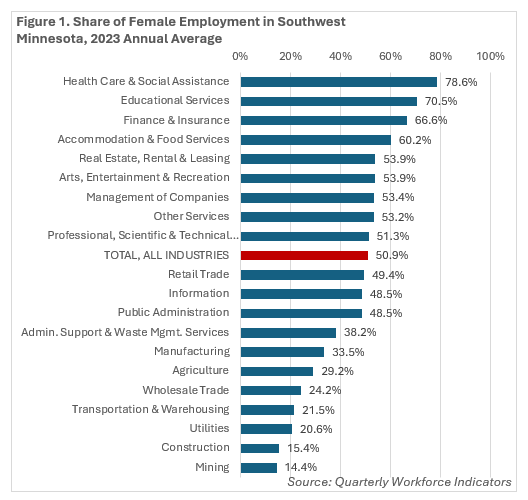 Southwest Minnesota is a national leader in agricultural production, and renewable energy.
Southwest Minnesota is a national leader in agricultural production, and renewable energy.
The region's thriving manufacturing sector includes food processing, machinery, printing, metal products, and computers and electronic products.
Want the freshest data delivered by email? Subscribe to our regional newsletters.
3/31/2025 10:57:58 AM
Amanda Blaschko, Luke Greiner
In celebration of Women's History Month, this blog includes some trends and characteristics of women in Southwest Minnesota's workforce. On an annual average in 2023, women held more than 92,000 jobs in Southwest Minnesota, accounting for just over half of all the jobs in the region. Data from the Quarterly Workforce Indicators program shows that the share of female employment has been increasing in recent years, and their contributions to economic success and growth in the region are invaluable.
From 2020 to 2023, the region regained about 11,600 jobs as industries recovered from the Pandemic Recession. Of those, women accounted for just over 6,000 of the jobs gained, compared to a gain of just over 5,500 jobs held by men. Female employment increased 7% since 2020, compared to a 6.6% increase for men.
While employment overall is relatively split between genders, certain industries are women dominated. For instance, Health Care & Social Assistance was the second largest employing industry in Southwest, but was easily the largest industry for women, with 26,380 jobs in 2023. Women hold almost 80% of total jobs in Health Care & Social Assistance, which is the highest share of the 20 main industries. Educational Services is the next largest employing industry for women, with nearly 17,000 jobs and a 70.5% share of all jobs (see Figure 1).

Other industries in the region that have high shares of female employment include Finance & Insurance (4,183 jobs, 66.6%) and Accommodation & Food Services (7,320 jobs, 60.2%). Five other industries – Real Estate, Rental & Leasing, Arts, Entertainment & Recreation, Management of Companies, Other Services, and Professional & Technical Services – were all just over half women in 2023.
In contrast, the industries with the smallest numbers and shares of women workers include Mining (32 jobs, 14.4%) and Utilities (172 jobs, 20.6%). Construction, Transportation & Warehousing and Manufacturing are much larger employing industries, but are traditionally male-dominated industries with less than one-third of the workforce in the region being women.
Like the regional economy overall, several industries saw quicker employment growth for women workers than for men coming out of the Pandemic Recession, with female employment expanding faster in seven of the 20 main industries. Instead, female job growth was highly concentrated in industries that saw stronger recoveries, including in Health Care & Social Assistance, Accommodation & Food Services, Public Administration and Other Services.
Despite some gender imbalances, the data shows opportunities exist for women in every industry. The South Central Workforce Council features a list of nontraditional careers for women on their website, highlighting options such as architecture, civil engineering, construction, criminal justice and plumbing, among others. Likewise, the Southwest Minnesota Private Industry Council has also secured grants to help with women's economic security.
For more information about employment trends in Southwest Minnesota, contact Amanda Blaschko at amanda.blaschko@state.mn.us or Luke Greiner at luke.greiner@state.mn.us.